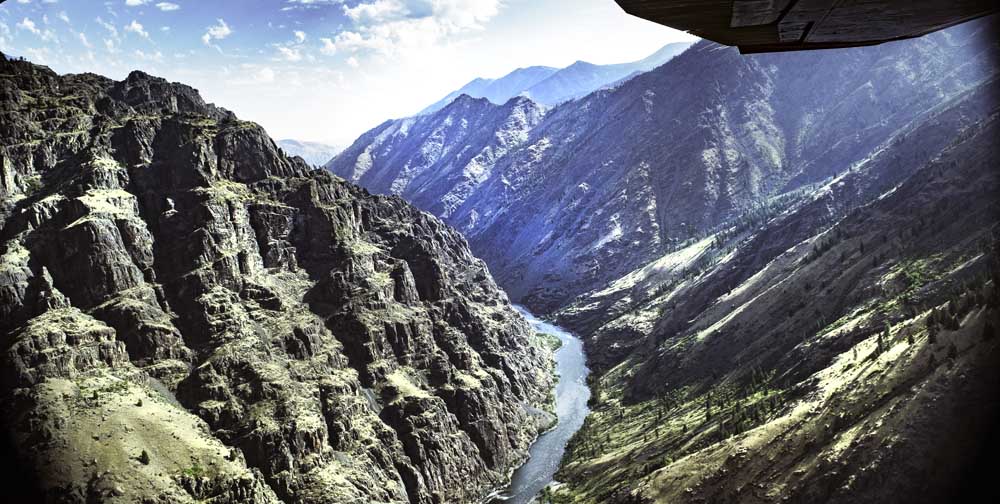Climate change effects upper regions of Hells Canyon the most
Published 4:15 pm Tuesday, March 10, 2020

- Ellen Morris BishopThe bottom of Hells Canyon along the Snake River is steep and rocky, without a lot of vegetation.
Hells Canyon, North America’s deepest gorge, is sequestered in Oregon’s far northeastern corner. It is renowned for its diverse wildlife population, including a vulnerable population of Rocky Mountain bighorn sheep and elk herds that frequent higher elevations. The effects of climate change in this 7,000-foot deep canyon are varied, and not entirely agreed upon by the biologists who work here.
Pat Matthews, the ODFW current district wildlife biologist, is a skeptic. Jim and Holly Akenson, wildlife biologists who worked for ODFW for years, including large animals in Hells Canyon, see the beginnings of significant changes, especially in higher elevations, as the climate warms.
Trending
Matthews is the district biologist for the Oregon Department of Fish and Wildlife with decades of experience in the area. He’s not buying climate change, at least not out in the canyon country of northeastern Oregon.
“You hear a lot about climate change in the news, but as far as what we’re seeing on the ground right here in Hells Canyon, everything, we’re just not seeing any kind of changes yet,” he said.
“I provided quite a few comments for our draft management plan that probably are contrary to a lot of the other biologists’ opinions. Climate change models are one thing. But you have to be able to verify that model on the ground and see if what the model tells you is really happening, and that’s one thing we’re not doing — we haven’t been able to see any difference,” he said.
Matthews also said that current weather patterns, particularly in winter, aren’t fitting the model.
“In our case out here, I mean the last three winters have been terribly hard,” he said. “To think that things are warming up or changing that way — it’s just not happening here.”
Asked whether, as climate warms, ODFW might transplant California desert bighorns, which are better adapted to warmer conditions to Hells Canyon to augment native Rocky Mountain bighorn natives, Matthews said “We will not bring in a more ‘deserty’ or ‘droughty’ type (bighorn) sheep,” he said. “We wouldn’t do that here because we’re trying to manage the native sheep that were here.”
Trending
The Akensons, wildlife biologists who have worked for ODFW across eastern Oregon, including Hells Canyon, see things differently than Matthews.
Holly Akenson, who currently serves on the Oregon Department of Fish and Wildlife Commission, said it’s hard to notice climate change effects on animals day by day and year by year because of the amount of variation.
Akenson said that in the higher elevations on both sides of the canyon the big change she’s seeing is losing the alpine biome because of increasing temperatures.
“Species like pikas (a small, furry animal that lives in higher altitude talus piles) are affected because they could get isolated on a smaller area and have areas less suitable in which to live,” she said.
“They need deep snow cover in the winter to keep them warm, and in the summer they don’t tolerate warm temperatures very well, which is why they generally live in higher elevations,” she said.
She said that if the habitat can’t keep the pikas warm, they move elsewhere. Akenson said she’d like to do a study of where they reside now.
Jim Akenson, who presently is the conservation director for the Oregon Hunters Association, thinks that ungulate (hoofed animal) migration in the canyon has been modified by climate change.
“There’s a distribution of seasonal range use, especially with elk, that is different than 20 or 30 years ago,” he said. “They’re spending more time at high elevation and less time at low — the nature of the warmer winters.”
Akenson said that during a jet boat trip up the Snake River in February a decade ago he saw plenty of elk at lower elevations. Recently, flying to check elk distribution for the Oregon Hunters Association, Akenson noted that elk were at much higher elevations in February than years before.
“They couldn’t get to mid-high elevation (in the past) in the canyon because of snow depth, but now they bounce around with a three or four thousand-foot elevation change,” he said. “I don’t know if that affects their survival, but it could affect range utilization and hit those higher elevation range lands a bit harder than before. It could be a factor if you’ve got 4,000 head of elk.”
Climate change evidence can be hard to find in this rugged and remote landscape. But Akenson also noted the canyon’s topography, which includes zones of hot desert to the alpine elevations can serve as a harbinger of things to come.
“If there’s a piece of landscape in our region that’s going to be a barometer for change it would be Hells Canyon,” he said.









